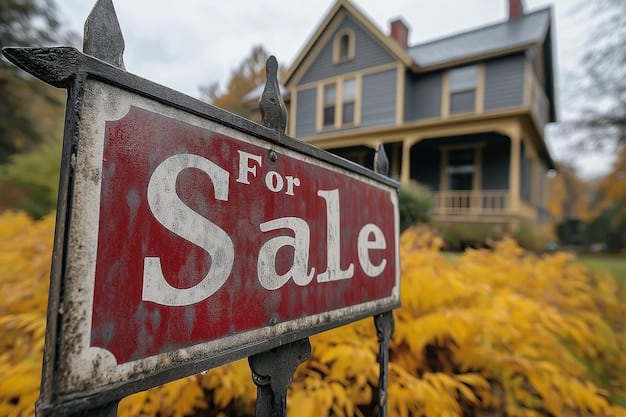US Housing Market Slowdown: Impact on Related Industries

The slowdown in the US housing market is creating significant ripple effects across various interconnected industries, leading to shifts in consumer spending, employment, and investment strategies nationwide.
The US housing market slowdown: How it’s affecting related industries is a topic of intense scrutiny for economists, businesses, and consumers alike. As interest rates climb, inflation remains a concern, and affordability challenges persist, the once-heated housing sector has begun to cool, sending reverberations far beyond real estate offices. This cooling trend isn’t just about fewer home sales; it triggers a domino effect, impacting everything from construction firms and mortgage lenders to furniture retailers and landscaping services. Understanding these interconnected dynamics is crucial for navigating the current economic climate.
Understanding the Current Housing Market Dynamics
The US housing market has transitioned from a frenzied seller’s paradise to a more balanced, albeit challenging, environment. Several key factors are contributing to this shift, including rising mortgage rates, persistent inflation, and a general tightening of economic conditions. These elements combine to reduce buyer enthusiasm and make homeownership less accessible for many.
The Role of Interest Rates and Inflation
Mortgage rates, directly influenced by the Federal Reserve’s monetary policy, have seen a significant increase. This makes borrowing more expensive, raising monthly payments for prospective homeowners. Consequently, some buyers are priced out of the market, while others decide to postpone their purchases, opting to wait until rates potentially decline. Inflation further complicates matters; as the cost of living rises, disposable income diminishes, reducing the ability of households to save for down payments or absorb higher mortgage costs. This dual pressure creates a formidable headwind for housing demand.
The Federal Reserve’s aggressive stance on interest rates, primarily aimed at curbing inflation, has been a major determinant. Higher rates translate directly to higher mortgage costs, leading to a decrease in overall housing affordability. This rapid change has left many potential buyers on the sidelines, waiting for more favorable conditions or adjusting their expectations. The cumulative effect of these financial pressures is a noticeable deceleration in housing transactions.
- Higher Borrowing Costs: Elevated mortgage rates make home loans more expensive.
- Reduced Affordability: Rising rates shrink the pool of eligible buyers.
- Inflationary Pressures: Increased cost of living impacts savings and discretionary income.
- Market Uncertainty: Buyers and sellers are hesitant due to economic instability.
Buyer Demand and Inventory Shifts
As affordability wanes, buyer demand naturally retrenches. Fewer eager buyers mean fewer bidding wars, longer time on the market for properties, and in some areas, price adjustments. Simultaneously, inventory levels have shown signs of increasing. While still historically low, the gradual rise in available homes, coupled with diminished demand, gives buyers slightly more leverage than they have had in recent years. This shift requires sellers to be more realistic about pricing and expectations. The equilibrium is slowly returning, but not without consequences for other sectors.
This evolving landscape presents both challenges and opportunities. For buyers, the increased inventory and slowing demand might eventually lead to more negotiating power. However, high interest rates remain a hurdle. For sellers, adapting to a less aggressive market means potentially lower offers and longer listing periods. This intricate dance between supply and demand is fundamental to understanding the broader economic impact.

Impact on the Construction and Building Materials Industry
The immediate and most direct impact of a housing market slowdown is felt by the construction and building materials industries. With fewer new homes being built and renovation projects potentially slowing, these sectors face significant headwinds. Reduced demand trickles down from large-scale developers to individual contractors and suppliers, affecting employment and revenue projections across the board.
New Home Construction Slowdown
Homebuilders are often the first to react to a cooling market. Faced with softening demand and higher financing costs for their projects, many respond by scaling back on new developments. Housing starts and building permit applications serve as early indicators of this trend. A decline in these metrics signals a pipeline reduction, meaning fewer jobs for construction workers and less demand for raw materials. This can lead to layoffs, project delays, and a general atmosphere of caution within the industry.
The ripple effect of fewer housing starts is substantial. It influences not only the thousands of workers directly employed in construction but also the broader network of engineers, architects, and specialized trades like electricians and plumbers. When the pace of new home construction diminishes, the entire ecosystem supporting it experiences a contraction.
- Reduced Housing Starts: Fewer new homes are entering the market.
- Project Delays: Builders postpone or cancel planned developments.
- Job Losses: Construction workers and related trades face layoffs.
- Strained Supply Chains: Lower demand can lead to excess inventory for suppliers.
Building Materials and Home Improvement
The slowdown extends to companies that produce and supply building materials, from lumber and concrete to fixtures and appliances. With fewer homes being built and renovations perhaps being delayed by homeowners facing economic uncertainty, the demand for these products decreases. This can result in lower sales volumes, inventory gluts, and pricing pressures for manufacturers and retailers. Home improvement stores, while partially insulated by smaller repair projects, can also see a decline in sales of larger, discretionary items.
Companies that rely heavily on residential construction orders, such as those manufacturing windows, roofing, or flooring, are particularly vulnerable. They may need to adjust production schedules, reduce shifts, or even consider temporary closures to align with the decreased demand. This creates a challenging environment for an industry that often thrives during periods of robust housing activity.
Consequences for the Financial Sector: Mortgages and Lending
The financial industry, particularly the mortgage and lending sectors, is inherently tied to the health of the housing market. A slowdown directly translates to reduced loan originations, increased competition for existing business, and potential challenges within lenders’ balance sheets. This impacts not only large banks but also smaller credit unions and independent mortgage brokers.
Declining Mortgage Originations
With fewer homes being bought and sold, the volume of new mortgage applications naturally declines. This directly impacts mortgage lenders, who earn fees from originating these loans. A substantial drop in originations means reduced revenue, often leading to cost-cutting measures, including layoffs in underwriting, processing, and sales departments. Lenders also face increased competition for the smaller pool of borrowers, which can drive down profit margins.
The scale of the decline can be significant. Mortgage companies that staffed up during the boom years to handle massive volumes of refinancing and purchase applications now find themselves overstaffed. This necessitates rapid adjustments to their operational models and workforce, creating uncertainty for employees and potentially affecting long-term business strategies.
Refinancing Market Shrinkage
Another critical component of the mortgage market, refinancing, also shrinks considerably during periods of rising interest rates. Homeowners are less inclined to refinance their existing loans when current rates are higher than their historical ones. This absence of refinancing activity further exacerbates the revenue challenges for mortgage lenders, as refinances often represent a substantial portion of their business volume. The combined effect of fewer purchases and reduced refinances places significant strain on the sector.
The refinancing boom of recent years provided a lucrative stream of income for lenders, allowing many to expand operations. As that stream dries up, the industry must pivot, focusing more intensely on the purchase market, which is also facing its own set of challenges. This dynamic shift necessitates strategic realignment and increased efficiency.
Ripple Effects on Retail and Home Furnishings
Beyond the immediate housing-related industries, the slowdown’s impact extends to retail and home furnishings sectors. When people buy fewer homes, they also buy less of what goes inside those homes. This affects everything from appliance sales to furniture purchases and general home decor, signifying a broader contraction in consumer spending related to housing transitions.
Reduced Home-Related Purchases
Buying a new home often triggers a cascade of related purchases: new furniture, appliances, electronics, and various home decor items. When home sales decline, this spending spree diminishes. Retailers that specialize in these goods, from large chains to independent boutiques, experience a noticeable dip in sales. This reduced demand can lead to excess inventory, necessitating discounts and impacting profit margins.
The discretionary nature of many of these purchases makes them particularly vulnerable during economic uncertainty. Consumers become more cautious with their spending when their financial outlook is less certain, choosing to repair existing items rather than replacing them, or simply doing without. This shift in consumer behavior directly affects the bottom line of retailers.
- Furniture and Decor Sales: Decline as fewer homes are bought.
- Appliance Market: Faced with lower demand for new home installations.
- Electronics and Home Entertainment: Less need for new setups in new residences.
- General Home Retailers: See a decrease in overall sales due to reduced new home purchases.
Impact on Moving and Logistics Services
A less obvious but significant impact is on the moving and logistics industry. Fewer home sales mean fewer people relocating, directly affecting moving companies, storage facilities, and even freight carriers that transport household goods. These businesses thrive on residential mobility, and a slowdown in housing transactions can lead to a reduction in their service demand.
Moving services are a direct proxy for real estate activity. When the housing market cools, the truck rentals slow, storage unit vacancies rise, and the overall volume of goods being transported for residential purposes decreases. This can put pressure on pricing and lead to a more competitive environment among service providers.
The Landscape and Gardening Industry’s Perspective
The landscaping and gardening industry, though seemingly distinct, is also intricately linked to the housing market’s health. New homeowners often invest significantly in improving their outdoor spaces. A slowdown in sales, coupled with economic caution, typically translates to reduced spending on these discretionary home improvements.
Decreased Landscaping Projects
New home buyers frequently allocate a portion of their budget to landscaping, whether it’s planting new gardens, installing patios, or improving curb appeal. When home sales drop, the pipeline for these larger landscaping projects diminishes. Landscape design firms, contractors, and nurseries might experience a downturn in demand for their services and products. Property owners might also delay significant outdoor renovations if they feel less confident about their home’s future value or their own financial stability.
This sector relies heavily on both new constructions and resale renovations. With fewer properties changing hands, the impetus for major external overhauls decreases. Instead of large-scale projects, homeowners might opt for routine maintenance or smaller, less costly improvements, if any at all.
Nursery and Garden Supply Stores
Similar to building materials, nurseries and garden supply stores can also feel the pinch. While they cater to existing homeowners for ongoing maintenance and hobby gardening, a significant portion of their sales can come from new landscaping initiatives. Reduced new home sales or stalled renovation projects mean fewer bulk purchases of plants, trees, and hardscaping materials. This can impact inventory management and necessitate adjustments in product offerings and marketing strategies.
Even smaller, local businesses within this industry are not immune. They rely on consistent customer flow and project leads. A general slowdown can mean leaner times, prompting them to seek out alternative revenue streams or focus more on existing customer retention through maintenance contracts rather than new installations.
Challenges and Opportunities for Related Industries
While a housing market slowdown presents undeniable challenges, it also fosters innovation and compels industries to adapt. Companies that can pivot their strategies, focus on new market segments, or enhance their value proposition are better positioned to weather the storm and emerge stronger.
Adapting Business Models
Businesses across affected industries are being forced to re-evaluate their strategies. For instance, construction companies might shift focus from new residential builds to commercial projects or public infrastructure. Mortgage lenders could explore diversification into other types of loans or emphasize refinancing for borrowers interested in tapping into equity, even if rates are higher. Retailers might concentrate on smaller, high-margin items or services rather than large, discretionary purchases.
Adaptation is key to survival. This could involve investing in new technologies, optimizing operational efficiencies, or exploring untapped markets. The companies that are nimble and responsive to changing market conditions will find ways to sustain themselves, even in a challenging environment.
Focus on Renovation and Maintenance
With fewer people moving, existing homeowners tend to focus more on improving their current residences. This could present an opportunity for certain segments of the construction, retail, and landscaping industries. Companies specializing in renovations, repairs, and general home maintenance might see increased demand as homeowners opt to enhance their current living spaces rather than seek new ones. This trend suggests a potential shift from transactional consumer behavior (buying/selling homes) to investment in current property assets.
Instead of a significant new landscape installation for a new home, homeowners might invest in a deck addition, a bathroom remodel, or energy-efficient upgrades. This subtle shift in consumer behavior can provide a buffer for companies able to meet this evolving demand. It emphasizes long-term value and comfort over immediate necessity.

Economic Implications and Future Outlook
The ripple effect of the housing market slowdown has broader economic implications, influencing consumer confidence, employment statistics, and overall economic growth. Monitoring these trends is crucial for policymakers and businesses as they navigate the current landscape and plan for the future.
Consumer Confidence and Spending
A healthy housing market often correlates with strong consumer confidence. When property values are rising, homeowners feel wealthier and are more inclined to spend. Conversely, a slowdown can dampen spirits, leading to more cautious consumer spending across various sectors. This decline in discretionary spending can further depress economic activity, creating a self-reinforcing cycle. The perception of job security also plays a role; concerns about layoffs in housing-related industries can make consumers hesitant to make major purchases.
The wealth effect from homeownership is significant. When that effect diminishes or reverses, it can noticeably impact retail sales, leisure activities, and other areas of the economy not directly tied to housing. Restoring consumer confidence is often a key objective in broader economic recovery efforts.
Employment and Workforce Adjustments
The slowdown inevitably leads to workforce adjustments in affected industries. Layoffs in construction, mortgage lending, and retail are direct consequences, impacting household incomes and potentially increasing unemployment rates. These job losses, while sometimes temporary, can have a significant effect on local economies and reinforce the cautious spending behavior mentioned earlier. Companies aim to right-size their operations for the new market realities, which often means reducing staff.
Government and industry leaders are often watchful of employment trends in these sectors, as significant job losses can signal a broader economic downturn. Support for retraining programs or unemployment benefits may become more prominent during these challenging periods to mitigate the impact on affected individuals.
Market Stabilization and Recovery Prospects
While the current slowdown presents challenges, housing markets are cyclical. Eventually, factors like population growth, job creation, and potentially stabilized or lower interest rates will contribute to a recovery. The question is not if the market will recover, but when and at what pace. Industries need to survive the downturn to capitalize on the eventual upswing. Government policies and economic indicators will play a crucial role in determining the timeline for stabilization and subsequent growth.
Patience and strategic planning are essential. Companies that manage their resources effectively, maintain strong balance sheets, and adapt their services can position themselves for renewed success when the market inevitably reaccelerates. The current slowdown is a recalibration, not a collapse, and understanding its nature is crucial for future prosperity.
| Key Area | Brief Impact Description |
|---|---|
| 🏗️ Construction & Materials | Reduced new builds, lower demand for building supplies leading to job cuts. |
| 💰 Financial Services | Fewer mortgage originations and refinance opportunities, impacting lender revenue. |
| 🛋️ Retail & Furnishings | Decline in sales of appliances, furniture, and home decor due to fewer moves. |
| 🌲 Landscape & Gardening | Reduced demand for new landscaping projects and bulk garden supplies. |
Frequently Asked Questions
▼
The primary causes are rising interest rates, driven by the Federal Reserve’s efforts to combat inflation, which increase mortgage costs and reduce affordability for prospective buyers. Additionally, persistent inflation erodes consumer purchasing power, making it harder to save for down payments and absorb higher housing expenses.
▼
Industries most directly affected include construction, building materials suppliers, and financial services (especially mortgage lenders). Indirectly, retail sectors like home furnishings, appliances, and general home goods, as well as moving and landscaping services, also experience significant impacts due to reduced home sales and related spending.
▼
Companies in affected industries often face reduced demand, leading to cost-cutting measures, including layoffs. This can be seen in construction (fewer new builds), mortgage lending (fewer loan originations), and retail (lower sales), all contributing to potential job losses and economic uncertainty for affected workers and their families.
▼
Yes, opportunities can arise for businesses capable of adapting. With fewer people moving, there might be increased demand for home renovation, repair, and maintenance services as homeowners opt to improve their current residences rather than buying new ones. Businesses focusing on these niches or diversifying into commercial sectors may find new avenues for growth.
▼
Predicting the exact duration is challenging as it depends on broader economic factors like inflation control, interest rate movements, and consumer confidence. Housing markets are cyclical, and while a full recovery may take time, periods of stabilization and gradual improvement are generally expected as economic conditions evolve and affordability improves.
Conclusion
The current slowdown in the US housing market is more than just a real estate trend; it’s a significant economic event with widespread implications. Its ripple effect touches various industries, compelling businesses to adapt, innovate, and reassess their strategies. While challenging, this period also highlights the interconnectedness of our economy and the importance of resilience. As the market seeks a new equilibrium, understanding these shifts is key for businesses and consumers alike to navigate the evolving landscape successfully and prepare for future opportunities.





